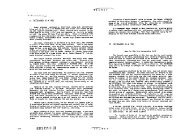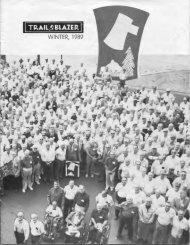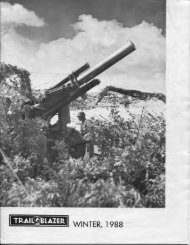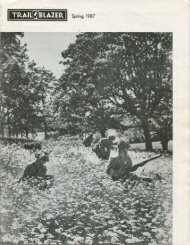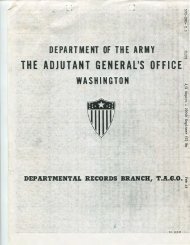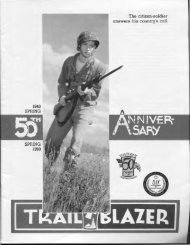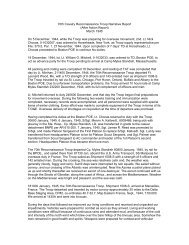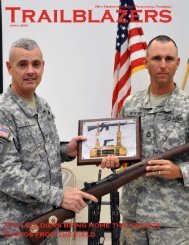Download - 70th Infantry Division Association
Download - 70th Infantry Division Association
Download - 70th Infantry Division Association
You also want an ePaper? Increase the reach of your titles
YUMPU automatically turns print PDFs into web optimized ePapers that Google loves.
The Engineers had 56 boats with four-man crews for each. Two platoons from Company G were sent to<br />
aid in carrying the boats to the debarkation points along the Saar. Our Regimental anti-tank guns and<br />
cannon were moved into covered positions along the river to give support by direct fire on the fortifications<br />
manned by the enemy on the north bank. Patrols from Companies B and C continually kept<br />
contact with the enemy by drawing fire from them. Whenever the enemy exposed his positions, our<br />
artillery and mortars immediately zeroed in. As a whole, the enemy fire was light, but we lost one officer<br />
and five enlisted men from one Company B patrol.<br />
The town of Schoeneck was decided upon as the de-trucking and rear assembly area.. This. town was in<br />
the 274th Sector.<br />
Our 3d Battalion was moving toward Schoeneck when we were notified by <strong>Division</strong> that the 274th would<br />
not allow our 3d Battalion to detruck and remain there. Therefore, the 3d Battalion was ordered to move<br />
back to Petite Rosselle, and they closed in at 1550.<br />
New plans called for Company C to send a patrol across the Saar River near Hostenbach, and, if<br />
successful, the company would follow. The whole 1st Battalion would then follow Company C.<br />
The 3d Battalion would then cross followed by the 2d Battalion. By 1800 all was in readiness. Company A<br />
was holding the line along the entire Regimental front; Company B was in an assembly area at<br />
Geislautern; Company C was in the vicinity of Werbeln; the 2d Battalion was in an assembly area in the<br />
vicinity of Klarenthal, and the 3d Battalion was assembled in Petite Rosselle. The weather was fair. All<br />
roads were dry.<br />
Two rubber boats with the patrol from Company C were launched at 2200 on the night of 19 March 1945.<br />
They met no opposition. The 2d and 3d Battalions were alerted to be ready to move on a half hour's<br />
notice.<br />
Once across the river, the patrol found an unoccupied pill box and ran into a mine field, exploding several<br />
mines. The Mine Platoon from the Regimental Anti-Tank Company and some of<br />
our attached Engineers next moved across the river to clear a path through the mine field. All Battalions<br />
held up pending the clearing of the mine field which consisted of anti-personnel and Schu mines, most of<br />
which were booby-trapped.<br />
In the early morning hours of 20 March we received a report from the 274th Regiment on our right that<br />
they were meeting resistance in the form of heavy small arms fire. They had taken<br />
two prisoners who stated that their unit had been ordered to withdraw across the river before daylight.<br />
By 0300 a path three feet wide had been cleared through the mine field, and the balance of Company C<br />
crossed the river followed by Company B. They were ferried across while the Engineers constructed a<br />
foot bridge and a vehicular bridge. Company A still held the line along the Regimental front and the 2d<br />
and 3d Battalions were awaiting orders to cross as soon as the way was clear.<br />
By 0700 the foot bridge was completed. The 3d Battalion, which had been moving up to the river, crossed<br />
on the foot bridge and completed the crossing by 0840. The 2d Battalion followed the 3d across the river.<br />
The Intelligence and Reconnaissance Platoon gained contact with the 259th <strong>Infantry</strong> Regiment of the<br />
65th <strong>Division</strong> on our left flank, and they maintained contact until Company A was relieved and moved<br />
across the river. The 274th on our right had moved their 3d Battalion across the river in the vicinity o£<br />
Ottenhausen and were meeting no resistance.<br />
At 0850 the Regiment set up a forward CP in Geislautern. By 1100 the 8 ton vehicle bridge had been<br />
completed in the vicinity of Hostenbach.<br />
The 1st Battalion secured the high ground to the north and northwest of Volklingen. The 2d Battalion<br />
moved into the town, while the 3d Battalion, after clearing out several houses just across the river, was<br />
ordered to proceed to Puttlingen.



